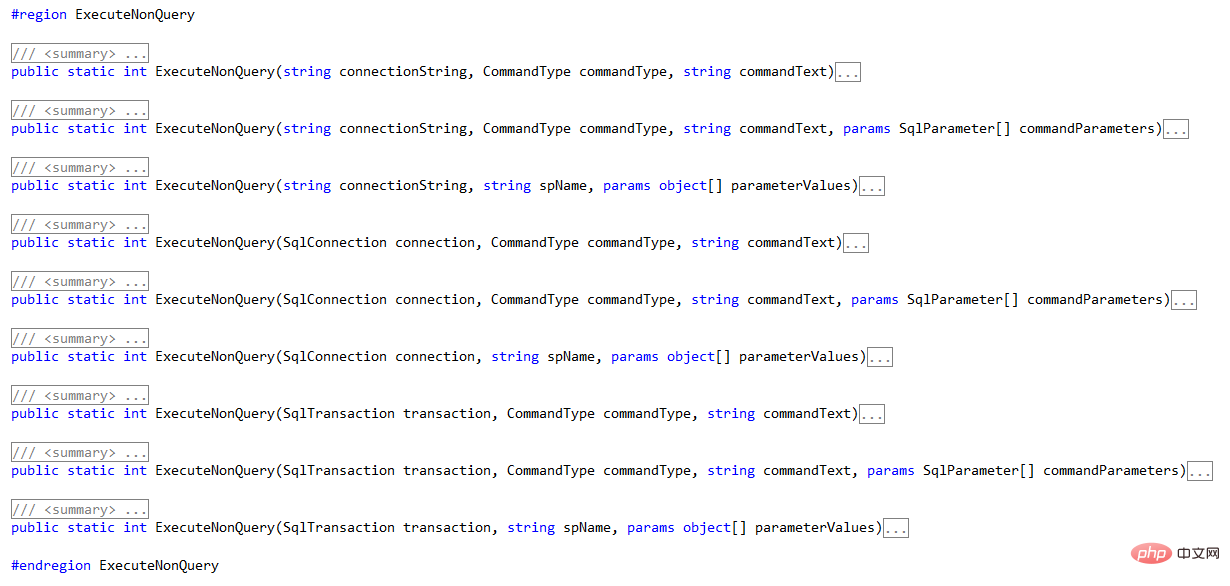What is the sqlhelper class?
The sqlhelper class refers to a database operation component based on the ".NET Framework". The component contains database operation methods; SqlHelper is used to simplify your repeated writing of those database connections SqlCommand or SqlDataReader, etc.

SqlHelper is a database operation component based on .NET Framework. The component contains database operation methods. SqlHelper is used to simplify your repetitive writing of database connections (SqlConnection), SqlCommand, SqlDataReader, etc. After SqlHelper is encapsulated, you usually only need to pass in some parameters to the method, such as database connection string, SQL parameters, etc., and then you can access the database, which is very convenient.
Recommended course: C# tutorial.
The SQLHelper.cs file contains two classes, namely SqlHelper and SqlHelperParameterCache.
//
public sealed class SqlHelper{}
public sealed class SqlHelperParameterCache{}These two classes are modified with the sealed modifier in front, indicating that it is a sealed class and cannot be used as a base class and cannot be inherited by other classes.
The SqlHelper class provides a set of static methods that can be used to issue many different types of commands to a SQL Server database.
The SqlHelperParameterCache class provides command parameter caching function, which can be used to improve performance. This class is used internally by many of the Execute methods (especially those overridden methods that just run stored procedures). Data access clients can also use it directly to cache specific sets of parameters for specific commands.
This time we put SqlHelperParameterCache aside and analyze the SqlHelper class.
Method
SqlHelper
There are four private methods, and the AssignParameterValues method has an overload:
AttachParameters: Add parameter array To the specified SqlCommand
AssignParameterValues: Assign values to the SqlParameters (parameters) array
PrepareCommand: Used to initialize the properties of the SqlCommand (command) (such as connection, transaction environment, etc.).
There are thirteen public methods: each method of querying the database uses a large number of overloads, and each method uses about eight overloads.
ExecuteNonQuery
This method is used to execute a command that does not return any rows or values. These commands are typically used to perform database updates, but can also be used to return output parameters from a stored procedure.
ExecuteDataset
This method returns a DataSet object that contains the result set returned by a command.
ExecuteReader
This method is used to return a SqlDataReader object, which contains the result set returned by a certain command.
ExecuteScalar
This method returns a value. This value is always the first column of the first row returned by this command.
ExecuteXmlReader
This method returns the XML fragment of the FOR XML query.
FillDataset
This method fills data into the DataSet.
UpdateDataset
This method is used to execute commands to add, delete, and modify DataSet.
CreateCommand
This method is used to create a SqlCommand.
Analysis
Let’s take the ExecuteNonQuery() method as an example to analyze:

What we see above is ExecuteNonQuery() Of the nine overloaded methods, the first three are for preparing queries, the middle three are for executing queries, and the last three are for SQL transaction queries. To break it down further, 2-1 executes a SQL statement without parameters, while 2-2 executes a SQL statement containing a parameter array (the parameter array can be empty), and 2-3 executes a stored procedure without a return value. . In fact, the 1-1 and 1-3 overloads are to facilitate parameter-less SQL statements, while the 1-3 and 2-3 overloads are just to facilitate calling stored procedures. Their essence is still the same as 1-2 and 2-2. Same. Here are some simple uses for overloaded methods.
Below we will use ExecuteNonQuery to execute SQL statements with parameters. You can use F11 to view the execution process statement by statement, which will help us understand the use of the SQLHelper class.
#region RegisterUser 注册用户
/// <summary>
/// 注册用户
/// </summary>
/// <param>userinfo实体
/// <returns>注册成功返回True,失败返回False</returns>
public bool RegisterUser(JFEntity.UserInfo userinfo)
{
string sql = @"INSERT INTO T_User VALUES(@userID,@userName,@userSex,@userPassword,@userLevel)";
SqlParameter[] sqlparamter = new SqlParameter[]
{
new SqlParameter("@userID", SqlDbType.Int),
new SqlParameter("@userName", SqlDbType.Char,30),
new SqlParameter("@userSex", SqlDbType.Char,6),
new SqlParameter("@userPassword", SqlDbType.Char,16),
new SqlParameter("@userLevel", SqlDbType.Char,8),
};
sqlparamter[0].Value = userinfo.userID;
sqlparamter[1].Value = userinfo.userName;
sqlparamter[2].Value = userinfo.userSex;
sqlparamter[3].Value = userinfo.userPassword;
sqlparamter[4].Value = userinfo.userLevel;
int result = SqlHelper.ExecuteNonQuery(SqlHelper.connectionString, CommandType.Text, sql, sqlparamter);
if (result != 0)
{
return true;//注册成功
}
else
{
return false;//注册失败
}
}
#endregionThe above is the detailed content of What is the sqlhelper class?. For more information, please follow other related articles on the PHP Chinese website!

Hot AI Tools

Undresser.AI Undress
AI-powered app for creating realistic nude photos

AI Clothes Remover
Online AI tool for removing clothes from photos.

Undress AI Tool
Undress images for free

Clothoff.io
AI clothes remover

AI Hentai Generator
Generate AI Hentai for free.

Hot Article

Hot Tools

Notepad++7.3.1
Easy-to-use and free code editor

SublimeText3 Chinese version
Chinese version, very easy to use

Zend Studio 13.0.1
Powerful PHP integrated development environment

Dreamweaver CS6
Visual web development tools

SublimeText3 Mac version
God-level code editing software (SublimeText3)

Hot Topics
 1378
1378
 52
52
 How to handle special characters in C language
Apr 03, 2025 pm 03:18 PM
How to handle special characters in C language
Apr 03, 2025 pm 03:18 PM
In C language, special characters are processed through escape sequences, such as: \n represents line breaks. \t means tab character. Use escape sequences or character constants to represent special characters, such as char c = '\n'. Note that the backslash needs to be escaped twice. Different platforms and compilers may have different escape sequences, please consult the documentation.
 What is the role of char in C strings
Apr 03, 2025 pm 03:15 PM
What is the role of char in C strings
Apr 03, 2025 pm 03:15 PM
In C, the char type is used in strings: 1. Store a single character; 2. Use an array to represent a string and end with a null terminator; 3. Operate through a string operation function; 4. Read or output a string from the keyboard.
 How to use various symbols in C language
Apr 03, 2025 pm 04:48 PM
How to use various symbols in C language
Apr 03, 2025 pm 04:48 PM
The usage methods of symbols in C language cover arithmetic, assignment, conditions, logic, bit operators, etc. Arithmetic operators are used for basic mathematical operations, assignment operators are used for assignment and addition, subtraction, multiplication and division assignment, condition operators are used for different operations according to conditions, logical operators are used for logical operations, bit operators are used for bit-level operations, and special constants are used to represent null pointers, end-of-file markers, and non-numeric values.
 The difference between char and wchar_t in C language
Apr 03, 2025 pm 03:09 PM
The difference between char and wchar_t in C language
Apr 03, 2025 pm 03:09 PM
In C language, the main difference between char and wchar_t is character encoding: char uses ASCII or extends ASCII, wchar_t uses Unicode; char takes up 1-2 bytes, wchar_t takes up 2-4 bytes; char is suitable for English text, wchar_t is suitable for multilingual text; char is widely supported, wchar_t depends on whether the compiler and operating system support Unicode; char is limited in character range, wchar_t has a larger character range, and special functions are used for arithmetic operations.
 The difference between multithreading and asynchronous c#
Apr 03, 2025 pm 02:57 PM
The difference between multithreading and asynchronous c#
Apr 03, 2025 pm 02:57 PM
The difference between multithreading and asynchronous is that multithreading executes multiple threads at the same time, while asynchronously performs operations without blocking the current thread. Multithreading is used for compute-intensive tasks, while asynchronously is used for user interaction. The advantage of multi-threading is to improve computing performance, while the advantage of asynchronous is to not block UI threads. Choosing multithreading or asynchronous depends on the nature of the task: Computation-intensive tasks use multithreading, tasks that interact with external resources and need to keep UI responsiveness use asynchronous.
 How to convert char in C language
Apr 03, 2025 pm 03:21 PM
How to convert char in C language
Apr 03, 2025 pm 03:21 PM
In C language, char type conversion can be directly converted to another type by: casting: using casting characters. Automatic type conversion: When one type of data can accommodate another type of value, the compiler automatically converts it.
 How to use char array in C language
Apr 03, 2025 pm 03:24 PM
How to use char array in C language
Apr 03, 2025 pm 03:24 PM
The char array stores character sequences in C language and is declared as char array_name[size]. The access element is passed through the subscript operator, and the element ends with the null terminator '\0', which represents the end point of the string. The C language provides a variety of string manipulation functions, such as strlen(), strcpy(), strcat() and strcmp().
 What is the function of C language sum?
Apr 03, 2025 pm 02:21 PM
What is the function of C language sum?
Apr 03, 2025 pm 02:21 PM
There is no built-in sum function in C language, so it needs to be written by yourself. Sum can be achieved by traversing the array and accumulating elements: Loop version: Sum is calculated using for loop and array length. Pointer version: Use pointers to point to array elements, and efficient summing is achieved through self-increment pointers. Dynamically allocate array version: Dynamically allocate arrays and manage memory yourself, ensuring that allocated memory is freed to prevent memory leaks.




